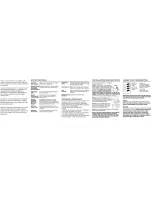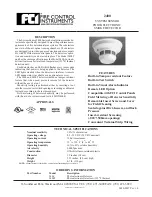
MOUNT the beam detector on corrugated metal walls,
sheet metal walls, external building sheathing, external
siding, suspended ceilings, steel web trusses, rafters, non-
structural beam, joists, or other such surfaces.
In cases where only one stable mounting surface as defined
above can be used, the transmitter/receiver unit should be
mounted to the stable surface and the reflector should
be mounted to the less stable surface. The reflector has
a much greater tolerance for the unstable mounting loca-
tions defined above.
Mounting Instructions
The transmitter/receiver unit may be mounted over a
recessed junction box. The cavity behind the detector is
then used for routing of the wiring from the junction box to
the terminal blocks on the detector. The transmitter/receiver
unit should be mounted to the wall such that unit covers the
recessed junction box in the wall completely. If the junction
box is not recessed then you may use the surface mount kit
(BEAMSMK). See the BEAMSMK installation instructions
for surface mounting instructions. The transmitter/receiver
unit can be mounted to the wall using the supplied drilling
template (see Appendix II). The detector base has 4 pri-
mary mounting keyholes, one in each corner of the base.
All four hole locations should be used to provide a secure
mounting. The outer housing of the beam detector is held
to the base using four screws. In order to mount the detec-
tor you must remove the outer housing first.
The reflector can be mounted to the wall using the sup-
plied drilling template (see Appendix III). The reflector
has 4 mounting holes, one in each corner. All four hole
locations should be used to provide a secure mounting.
The reflector must be mounted such that it is within 10°
in both the X and Y planes of the transmitter/receiver unit.
See Figure 5a. The reflector must also be mounted such
that plane of the reflector is perpendicular to the optical
line of sight to the transmitter/receiver unit. The maximum
tolerance for non-perpendicular mounting locations is 10°.
See Figure 5b. If the reflector cannot be mounted within
10° of the transmitter/receiver unit then the multi-mount
kit (BEAMMMK) may be used to provide greater angular
adjustment of the transmitter/receiver unit. If the perpen-
dicular plane of the reflector cannot be mounted within 10°
of the optical line of sight then the multi-mount kit can be
used for the reflector. See BEAMMMK instructions.
To aid in locating the reflector in the alignment mirror
at long distances a bright orange sticky backed piece of
paper is provided. Remove the protective backing from
the orange sticker. Temporarily affix the orange paper next
to the reflector using the sticky backing of the paper. The
location of the sticky paper is not critical. It may be placed
anywhere near the reflector as long as it not covering the
reflective surface of the reflector. This sticky paper should be
removed once the installation is completed.
Figure 5a. Reflector Mounting Guidelines
WA
LL
REFLE
CTOR
Acceptable mounting
locations for r eflector
10
°
10
°
C0258-00
Figure 5b. Reflector Mounting Guidelines
10
°
maximum
optical line of sight
REFLECTOR
C0259-00
Mounting Considerations for Single Ended Beam
Detectors
There must be a permanent clear line of vision between the
detector and the reflector. Reflective objects must not be
near the line of vision between the detector and reflector.
Reflective objects too near to the line of sight can reflect
the light beam from the transmitter to the receiver. If this
occurs, the detector will not be able to distinguish these
reflections from those of the reflector and the protected
space will be compromised. Reflective objects should be a
minimum of 4 feet (1.2m) from the line of sight between
the detector and reflector. In cases where reflective objects
cannot be avoided, the complete reflector blockage test can
be used to determine if the installation is acceptable. See
Testing and Maintenance Section of this manual.
Light sources of extreme intensity such as sunlight and hal-
ogen lamps, if directed at the receiver, can cause a dramatic
signal change resulting in fault and alarm signals. To prevent
this problem direct sunlight into the transmitter/receiver
unit should be avoided. There should be a minimum of 10°
between the pathway of the light source and detector and
the line of sight between detector and reflector.
Operation of the detector through panes of glass should
be avoided. Since single ended beam detectors operate on
D400-74-00
5
I56-2542-00R


































